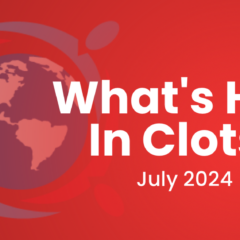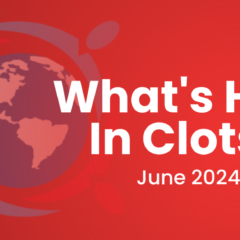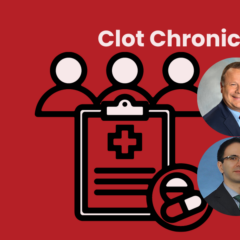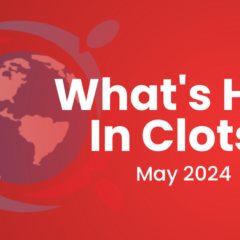Last updated on
What’s Hot in Clots – December 2022
Key Updates in Thrombosis
Table of Contents
In patients with cancer, even superficial vein thrombosis matters
Data from the Investigating SIGnificant Health TrendS in the management of Superficial Vein Thrombosis (INSIGHTS-SVT) study indicate that cancer patients with superficial vein thrombosis have a much higher risk of symptomatic VTE, including DVT and PE. The 1-year cumulative incidence of VTE in cancer patients was 18.2%! The ideal type and duration of antithrombotic therapy in cancer patients with superficial vein thrombosis needs more investigation. Learn more!
Warfarin tied to lower risk of arterial thrombosis in patients with thrombotic antiphospholipid syndrome
In a meta-analysis of four trials of patients with thrombotic antiphospholipid syndrome who were randomized to direct oral anticoagulants (DOACs) or vitamin-K antagonists, the risk of subsequent thrombotic events was significantly less with vitamin-K antagonists. The excess risk with DOACs was driven by arterial thrombotic events, particularly stroke. Findings were similar even in those who did not have triple-positive disease. Learn more!
BRIGHT4: Is there a comeback for bivalirudin?
Whether bivalirudin confers benefit compared with unfractionated heparin for patients with ST-elevation myocardial infarction has been a HEATed conversation with mixed results from prior trials. Although some benefit was seen in reducing bleeding events, use of bivalirudin was associated with excess risk of stent thrombosis in prior trials. Findings from the BRIGHT-4 trial show that bivalirudin with a high-dose post-PCI infusion, compared with heparin, reduces both major bleeding and all-cause mortality without an increase in stent thrombosis. Learn more!
Tongxinluo: Scorpion, leech, cockroach, and centipede to heal myocardial infarction?
One of the widely discussed late-breaking presentations at AHA 2022 was the CTS-AMI trial, in which Chinese patients with STEMI undergoing primary PCI who received tongxinluo, compared with placebo, had a lower risk of developing a composite of cardiac death, reinfarction, stroke, or emergent revascularization. But what is tongxinluo? According to the trial design manuscript, it includes: “Radix ginseng, Buthus martensi, Hirudo, Eupolyphaga seusteleophaga, Scolopendra subspinipes, Periostracum cicadae, Radix paeoniae rubra, Semen ziziphi spinosae, Ligum dalbergiae odoriferae, Ligum Santali albi, and Borneolum syntheticum.” Or in simple terms, it includes extracts from scorpion, leech, cockroach, centipede, insect cast, and others! The full trial results are yet to be published. Is it a magic potion harnessed from venoms? Or just too good to be true? Learn more!
Enjoy reading these updates? Be sure to subscribe to get the latest updates each month!

Behnood Bikdeli, MD, MS
Cardiologist, Section of Vascular Medicine, Division of Cardiovascular Medicine, Brigham and Women’s Hospital
Investigator, Thrombosis Research Group, Division of Cardiovascular Medicine, Brigham and Women’s Hospital
Instructor, Harvard Medical School
Investigator, Yale/ YNHH Center for Outcomes Research and Evaluation, Yale School of Medicine
Investigator, Cardiovascular Research Foundation



